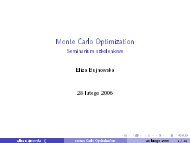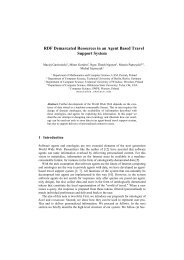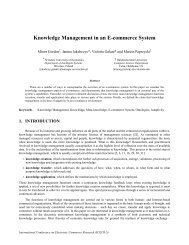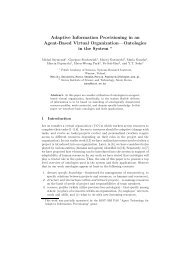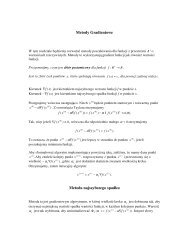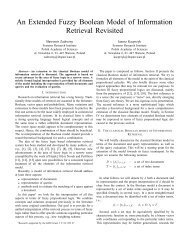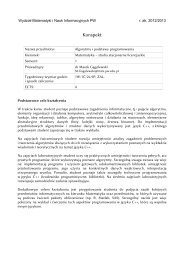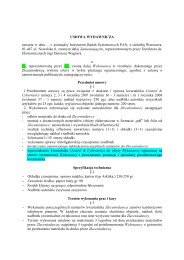Combining Information from Multiple Internet Sources
Combining Information from Multiple Internet Sources
Combining Information from Multiple Internet Sources
Create successful ePaper yourself
Turn your PDF publications into a flip-book with our unique Google optimized e-Paper software.
During algorithm processing there is no direct participation of the Search Agents (SAs) in the<br />
game itself. The whole game logic is performed by the Manager Agent (MA). MA invokes all<br />
necessary methods to perform the game. SAs in this game are used as grouping factor for result sets<br />
– each agent corresponds to the search engine which returned a particular result set; and then result<br />
set is assigned to an agent. Algorithm was centralized for unification purposes (Consensus method<br />
described in 3.4 is also highly centralized algorithm) and also to achieve greater reliability and<br />
speed that could be seriously lowered due to the communication overhead or communication<br />
failures. In fact SAs are not necessary; those were used as a somehow interesting way to deal with<br />
the information retrieval task.<br />
Below the pseudo code for the main game part is presented. This part is started after the<br />
algorithm <strong>from</strong> section 3.4.1 is finished and the result sets have been processed.<br />
Input: Map containing URL rankings<br />
Output: 10 URLs<br />
BEGIN<br />
1. repeat until there are 10 URLs in answer list<br />
2. repeat until one agent remains<br />
3. find agent whose URL is the highest ranked URL, find also the aforementioned URL –<br />
let those be FA (first agent) and FAU (first agent URL)<br />
4. find agent whose URL is the second highest ranked URL, also find the aforementioned<br />
URL – let those be SA (second agent) and SAU (second agent URL)<br />
5. construct keep and change payoff values as follows:<br />
FA keep<br />
SA keep<br />
= rank<br />
= rank<br />
( FA, FAU ) − rank(<br />
FA,<br />
SAU )<br />
( SA, SAU ) − rank(<br />
SA,<br />
FAU )<br />
( FA FAU )<br />
rank , + rank(<br />
FA,<br />
SAU )<br />
FA change<br />
=<br />
2<br />
( SA SAU )<br />
rank , + rank(<br />
SA,<br />
FAU )<br />
SA change<br />
=<br />
2<br />
determine agent actions by comparison of their values – the action with higher value<br />
is the chosen action<br />
6. determine round winner:<br />
−if action assigned to one of agents (FA, SA) is keep action and other is change the<br />
one that selected keep is marked as winner, the second one is marked as loser and<br />
is discarded <strong>from</strong> further game<br />
−if both of them are assigned the same action their URL ranks are replaced by the<br />
values of the chosen action; if this situation occurs second time the following<br />
takes place:<br />
Depending on the initial ranks of the URLs assigned to the agents the one<br />
with the higher ranking is considered to be a winner of the round, and the<br />
second one is loser. Then the loser and its result set is discarded <strong>from</strong> the<br />
next rounds of the negotiation until the game is restarted (2.)<br />
7. add URL to answer list<br />
8. remove the URL <strong>from</strong> further evaluation<br />
9. go to 2 (next round)<br />
END<br />
Listing 3.1.4 Game theory main algorithm<br />
25



